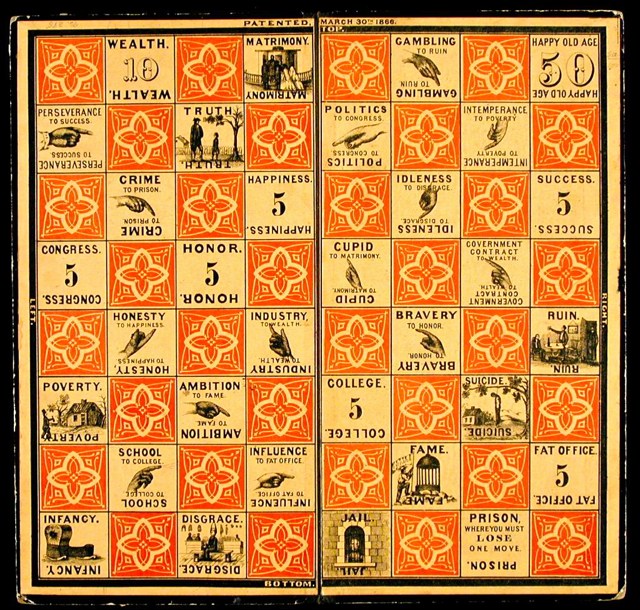The 1950s: Candy Land
While Candy Land was actually introduced to the world in 1949, it reigned as one of the leading popular games throughout the ’50s. Today, it continues to be popular among children and certainly nostalgic for adults. According to Tim Walsh, an American game inventor and writer, 60 percent of households that have a 5-year-old child, own the game Candy Land. Clearly, its popularity did not cease after the ’50s came to a close. And we are certain that the upcoming ’20s will be no different.The 1960s: The Game of Life

The Big Game Hunter permanent collection
The 1970s: Mystery Date
While the board game Mystery Date was released during 1965, its popularity spiked during the ’70s upon updating. If the tagline doesn’t give too much away, ‘Meet Your Secret Admirer,’ the game was targeted toward young girls. The goal was to land your dream date with one of the boys who waited behind the door while avoiding “the dud” who wore normal clothing. The more admirable suitors were dressed in either formal, beach, skiing or bowling attire. Throughout the years, this game has notably changed its aesthetic to keep up with the varying decades.The 1980s: Pictionary
In 1987, Pictionary sold 3 million copies. It was then deemed 2nd place on the highest selling games ranking. The top spot was held by the Nintendo Entertainment System. Similar to the idea of charades, players draw hints for their teammates with the end goal of guessing the correct word being sketched. It is the game’s simplicity and the ability to evoke competition that created its popularity during family game nights. Personally, I find Pictionary to be more comfortable to play than charades. Rather than using your body to act out something, you put pen to paper and allow the motionless drawing to do all the action.The 1990s: 13 Dead End Drive
You may remember this board game from its sensationalized and quirky advertising TV commercials. This murder-themed board game was released in 1993. The objective of the game is to inherit the fortune that was left by the wealthy character Aunt Agatha. The goal is to take down each of your opponents by trapping them in an area that will knock them down and boot them out of the game. Instead of playing on a flat surface with game pieces, this game’s structure implemented a 3-D board to issue a more realistic gaming experience.The 2000s: Apples to Apples
This board game was released to the public halfway through 1999, as the new decade was approaching. Throughout the 2000s, and even much of the ’10s, this game was a phenomenon. It brought families with children of all ages together for game night and it wasn’t short of entertainment. I remember playing the game with my parents, siblings, aunts, uncles and cousins, as we gathered around the living room hoping that our card would be the chosen one. Nearly 15 years later, my family continues to crack jokes about that family game night. Funny Story: If you’re wondering why my family still talks about the time we played Apples to Apples during Fall 2009, here’s the story. It was my sister’s turn to be the judge, so she read her adjective card aloud: Annoying. We all quickly and competitively slid our one card to my sister in the hopes that we would get chosen and find ourselves one step closer to winning. My sister read through each card and decided to pick Patrick Swayze. The adults gasped, wondering why she had chosen the beloved actor who had actually died only a few months prior. My sister responded with, “I just didn’t know who he was, which was annoying. So he gets the ‘Annoying’ card!” My aunts and uncles responded with, “too soon, too soon.” Turns out, my brother had won that round and was ironically using it as a throw-away card. To this day, anytime Patrick Swayze is mentioned we all say, “too soon, too soon.”The 2010s: Codenames
The original word guessing game was released in 2015. Since then, it has broadened its board game horizons and created different editions, with the same overall goal but varying concepts manifested. During Codenames word game, if you are the spymaster in your team of two, your goal is to describe the word(s) to your partner without specifically using any of the words in your set. This game calls for strategy, teamwork and, of course, secrecy. If you have a competitive nature, try this one and play it as a final hoorah to the ’10s decade. (But I’m positive it’ll continue its popularity reign into the ’20s).The Future: 2020s
At Shuffled Ink, we can manufacture any board game that wish to design. Throughout the years we’ve assisted in the creation of your customized board games, complete with customized accessories, booklets, dice, instructions, spinners, timers, tuck or setup boxes and more. You all, our clients, are the future of what board games have to offer in 2020. What will board games look like in the future? We have an idea that may or may not be wildly far-fetched. Nevertheless, that question is for your innovative minds to decide and for us to help make possible. ● Official Shuffled Ink website: ShuffledInk ● Make Your Own Custom Playing Cards at: ShuffledInk ● Make Your Own Custom Tarot Cards at: ShuffledInk ● Make Your Own Custom Card Games at: ShuffledInk ● Make Your Own Custom Flash Cards at: ShuffledInkAbout Shuffled Ink
Shuffled Ink is a multigenerational family business that specializes in printing custom playing cards, tarot & flash cards, custom card games, packaging and more for businesses and individuals worldwide.
To receive complimentary samples of our card products, either follow this link or please include your delivery address and phone number on your custom quote request form.